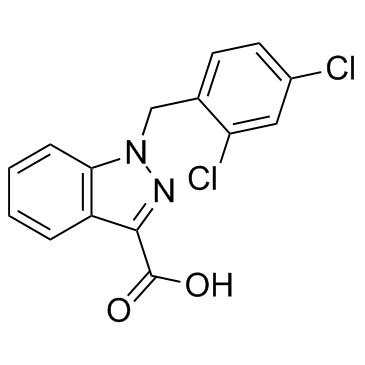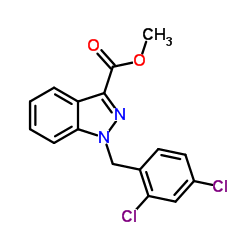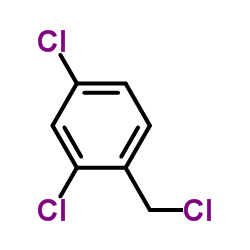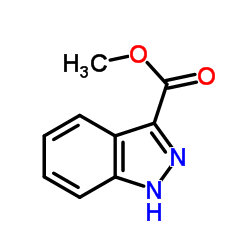50264-69-2
| Name | lonidamine |
|---|---|
| Synonyms |
1-(2,4-Dichlorobenzyl)-1H-indazole-3-carboxylic acid
1H-Indazole-3-carboxylic acid, 1-[(2,4-dichlorophenyl)methyl]- DICA Lonidaminum Lonidamin Lonidaminum [INN-Latin] MFCD00866285 Diclondazolic acid Lonidamine EINECS 256-510-0 1-[(2,4-dichlorophenyl)methyl]indazole-3-carboxylic acid 1-[(2,4-dichlorophenyl)methyl]-1H-indazole-3-carboxylic acid Lonidamina 1-(2,4-Dichlorobenzyl)-1H-indazole-3-carboxylic acid Diclondazolic acid Doridamina |
| Description | Lonidamine is an orally administered small molecule hexokinase inactivator.Target: OthersLonidamine is a derivative of indazole-3-carboxylic acid, which for a long time, has been known to inhibit aerobic glycolysis in cancer cells. It seems to enhance aerobic glycolysis in normal cells, but suppress glycolysis in cancer cells. This is most likely through the inhibition of the mitochondrially bound hexokinase. Later studies in Ehrlich ascites tumor cells showed that lonidamine inhibits both respiration and glycolysis leading to a decrease in cellular ATP. Clinical trials of lonidamine in combination with other anticancer agents for a variety of cancers has begun. Lonidamine has been used in the treatment of brain tumours in combination with radiotherapy and temozolomide. Results showed that a combination of temozolomide and lonidamine at clinically achievable, low plasma concentrations, could inhibit tumour growth, and lonidamine could reduce the dose of temozolomide required for radiosensitization of brain tumours. From Wikipedia. |
|---|---|
| Related Catalog | |
| References |
| Density | 1.5±0.1 g/cm3 |
|---|---|
| Boiling Point | 537.9±45.0 °C at 760 mmHg |
| Melting Point | 207-209°C |
| Molecular Formula | C15H10Cl2N2O2 |
| Molecular Weight | 321.158 |
| Flash Point | 279.1±28.7 °C |
| Exact Mass | 320.011932 |
| PSA | 55.12000 |
| LogP | 4.32 |
| Vapour Pressure | 0.0±1.5 mmHg at 25°C |
| Index of Refraction | 1.678 |
| Storage condition | Store at RT |
CHEMICAL IDENTIFICATION
HEALTH HAZARD DATAACUTE TOXICITY DATA
MUTATION DATA
|
| Symbol |


GHS07, GHS08 |
|---|---|
| Signal Word | Danger |
| Hazard Statements | H302-H351-H360 |
| Precautionary Statements | P201-P281-P308 + P313 |
| Personal Protective Equipment | Eyeshields;full-face particle respirator type N100 (US);Gloves;respirator cartridge type N100 (US);type P1 (EN143) respirator filter;type P3 (EN 143) respirator cartridges |
| Hazard Codes | T:Toxic; |
| Risk Phrases | R60;R22;R40 |
| Safety Phrases | S53-S22-S36/37/39-S45 |
| RIDADR | NONH for all modes of transport |
| WGK Germany | 3 |
| RTECS | NK7886000 |
| HS Code | 2933990090 |
|
~% 
50264-69-2 |
| Literature: THRESHOLD PHARMACEUTICALS, INC. Patent: WO2005/120498 A2, 2005 ; Location in patent: Page/Page column 18; 20 ; |
|
~% 
50264-69-2 |
| Literature: THRESHOLD PHARMACEUTICALS, INC. Patent: WO2005/120498 A2, 2005 ; Location in patent: Page/Page column 22 ; |
| Precursor 2 | |
|---|---|
| DownStream 1 | |
| HS Code | 2933990090 |
|---|---|
| Summary | 2933990090. heterocyclic compounds with nitrogen hetero-atom(s) only. VAT:17.0%. Tax rebate rate:13.0%. . MFN tariff:6.5%. General tariff:20.0% |



![1-[(2,4-dichlorophenyl)methyl]indazole-3-carbonyl chloride structure](https://image.chemsrc.com/caspic/271/874110-84-6.png)